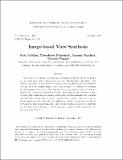Browsing Computer Science and Artificial Intelligence Lab (CSAIL) by Title
Now showing items 1578-1597 of 3804
-
Image-Based View Synthesis
(1997-01-01)We present a new method for rendering novel images of flexible 3D objects from a small number of example images in correspondence. The strength of the method is the ability to synthesize images whose viewing position ... -
Imagination and Situated Cognition
(1991-02-01)A subsumption-based mobile robot is extended to perform cognitive tasks. Following directions, the robot navigates directly to previously unexplored goals. This robot exploits a novel architecture based on the idea ... -
Immediate-Mode Ray-Casting
(1999-06)We propose a simple modification to the classical polygon rasterization pipeline that enables exact, efficient raycasting of bounded implicit surfaces without the use of a global spatial data structure bounding hierarchy. ... -
The Impact of Communication Locality on Large-scale Multiprocessor Performance
(1992-02)As multiprocessor sizes scale and computer architects turn to interconnection networks with non-uniform communication latencies, the lure of exploiting communication locality to increase performance becomes inevitable. ... -
The Impact of Communication Locality on Large-scale Multiprocessor Performance
(1992-06)As multiprocessor sizes scale and computer architects turn to interconnection networks with non-uniform communication latencies, the lure of exploiting communication locality to increase performance becomes inevitable. ... -
The Impact of Layer Assignment Methods on Layout Algorithms for Integrated Circuits
(1983-08)Programs for integrated circuit layout at the module assembly level are typically decomposed into two phases - placement and routing. In this thesis we investigate a third phase which is often implicitly assumed - layer ... -
The Impact of Synchronous Communication on. The Problem of Electing a Leader in a Ring
(1984-04)We consider the problem of electing a leader in a synchronous ring of n processors. We obtain both positive and negative results. One the one hand, we show that if processor ID's are chosen from some countable set, then ... -
Impediments to Universal Preference-based Default Theories
(1989-10)Research on nonmonotonic and default reasoning has identified several important criteria for preferring alternative default inferences. The theories of reasoning based on each of these criteria may uniformly be viewed as ... -
Implementation of a Theory for Inferring Surface Shape from Contours
(1982-08-01)Human vision is adept at inferring the shape of a surface from the image of curves lying across the surface. The strongest impression of 3-D shape derives from parallel (but not necessarily equally spaced) contours. ... -
Implementation of a Theory of Edge Detection
(1980-04-01)This report describes the implementation of a theory of edge detection, proposed by Marr and Hildreth (1979). According to this theory, the image is first processed independently through a set of different size filters, ... -
An Implementation Scheme for Array Operations in Static Data Flow Computers
(1982-05)The mapping of array operations in VAL programs on a static data flow machine with array memory is studied. The flow dependency graph is introduced as a model of array operations in VAL programs. The balancing and ... -
Implementing Asynchronous Distributed Systems Using the IOA Toolkit
(2004-10-06)This document is a report about the capabilities and performance of the IOA Toolkit, and in particularthe tools that provide support for implementing and running distributed systems (checker,composer, code generator). The ... -
Implementing Atomic Data through Indirect Learning in Dynamic Network
(2006-10-12)Developing middleware services for dynamic distributed systems, e.g., ad-hoc networks, is a challenging task given that suchservices must deal with communicating devices that may join and leave the system, and fail or ... -
Implementing Distributed Systems Using Linear Naming
(1993-03-01)Linear graph reduction is a simple computational model in which the cost of naming things is explicitly represented. The key idea is the notion of "linearity". A name is linear if it is only used once, so with linear ... -
Implementing Internet Remost Logic on a Personal Computer
(1982-12)This thesis demonstrates that a desktop personal computer can support an efficient internet remote login implementation with the same protocols used by large mainframes. It describes a project in which the Telnet remote ... -
Implementing Multi-process Primitives in a Multiplexed Computer System
(1968-11)In any computer system primitive functions are needed to control the actions of processes in the system. This thesis discusses a set of six such process control primitives which are sufficient to solve many of the problems ... -
Implementing Probabilistically Checkable Proofs of Proximity
(2005-08-08)Abstract: In this paper, we describe a proof-of-concept implementation of the probabilistically checkable proof of proximity (PCPP) system described by Ben-Sasson and Sudan in \\cite{bs05}. In particular, we implement a ... -
Implementing Sequentially Consistant Shared Objects using Broadcast and Point-To-Point Communications
(1995-06)A distributed algorithm that implements a sequentially consistent collection of shared read/update objects using a combination of broadcast and point-to-point communication is presented and proved correct. This algorithm ... -
Implementing Universal Computation in an Evolutionary System
(2002-07-01)Evolutionary algorithms are a common tool in engineering and in the study of natural evolution. Here we take their use in a new direction by showing how they can be made to implement a universal computer. We consider ...



















